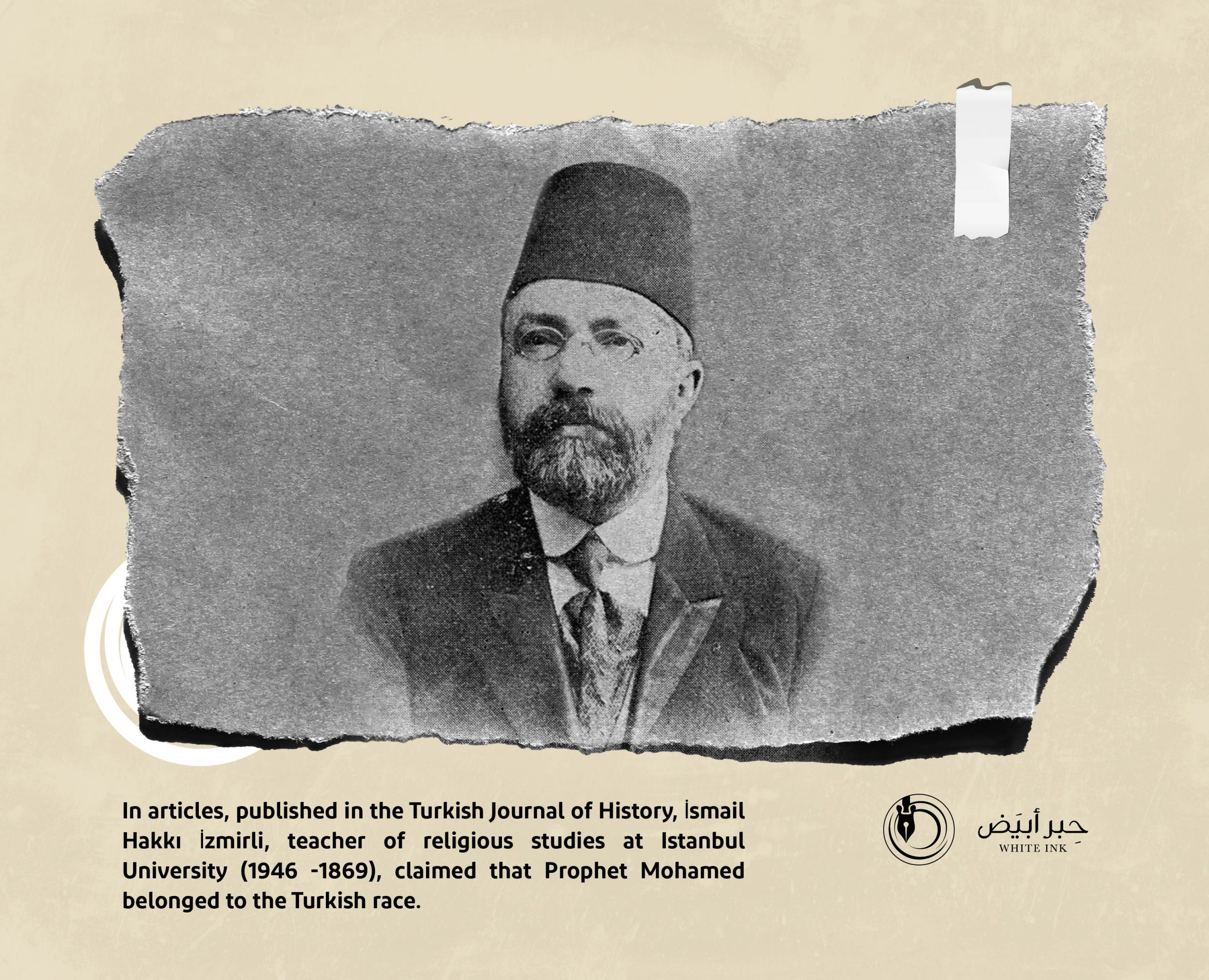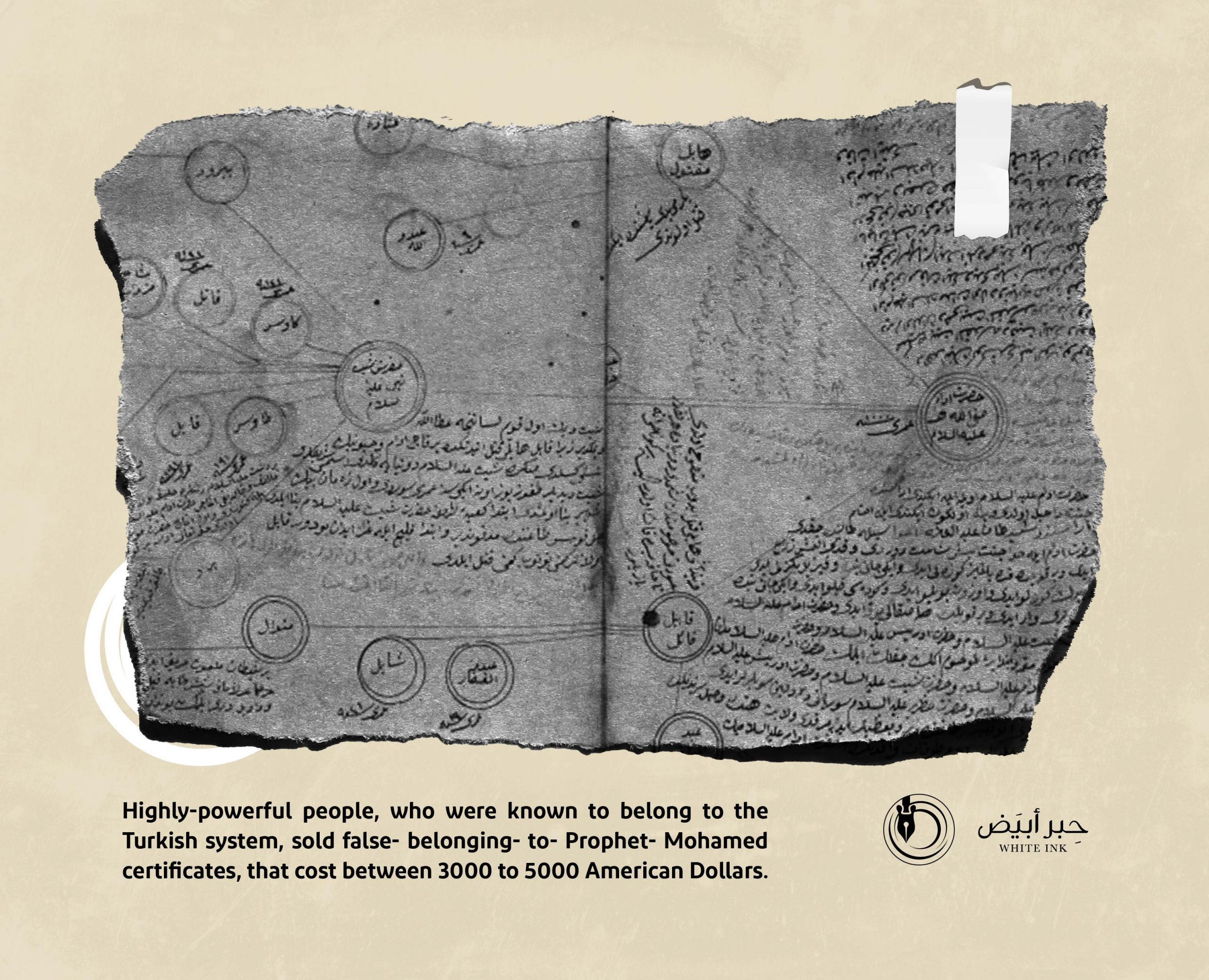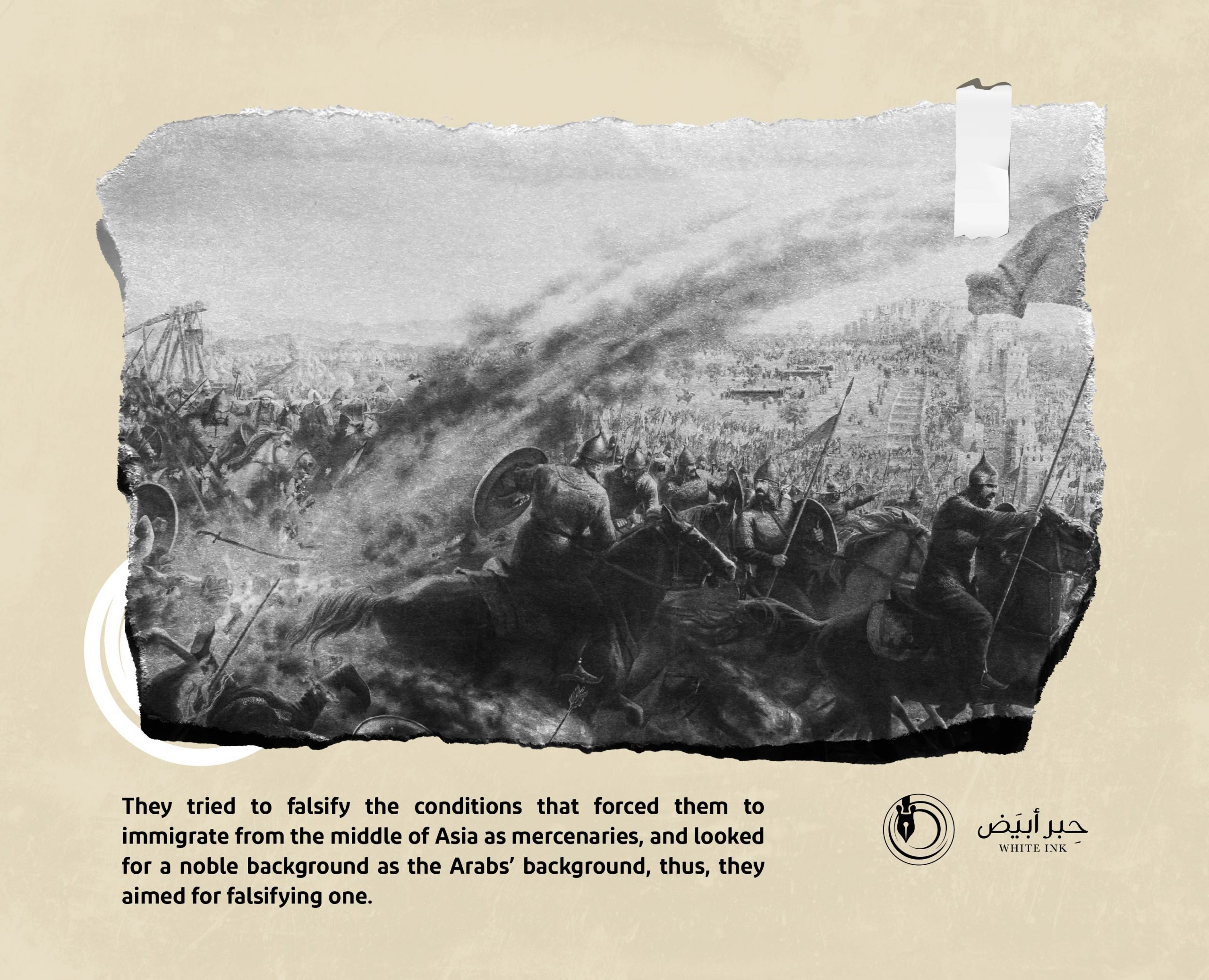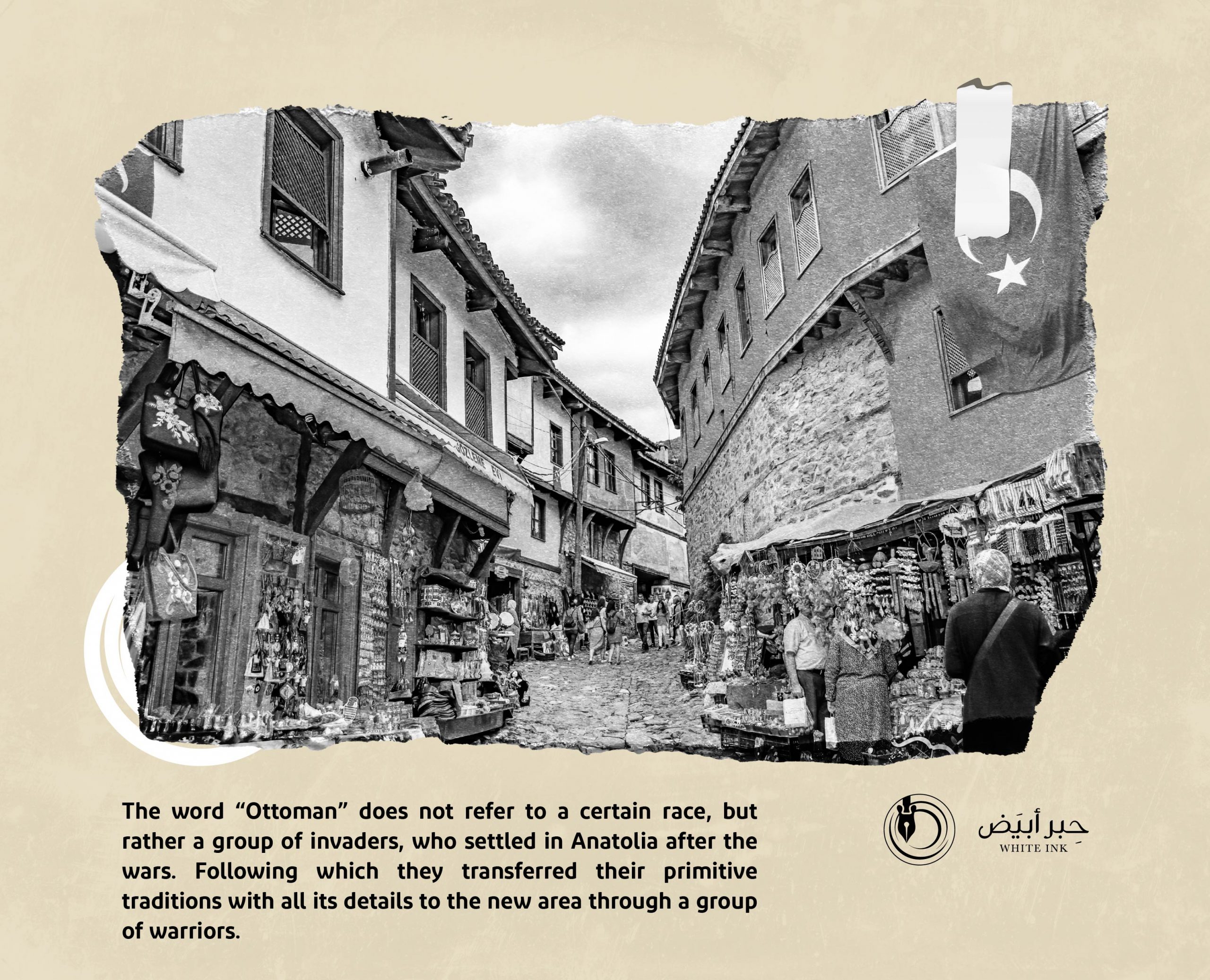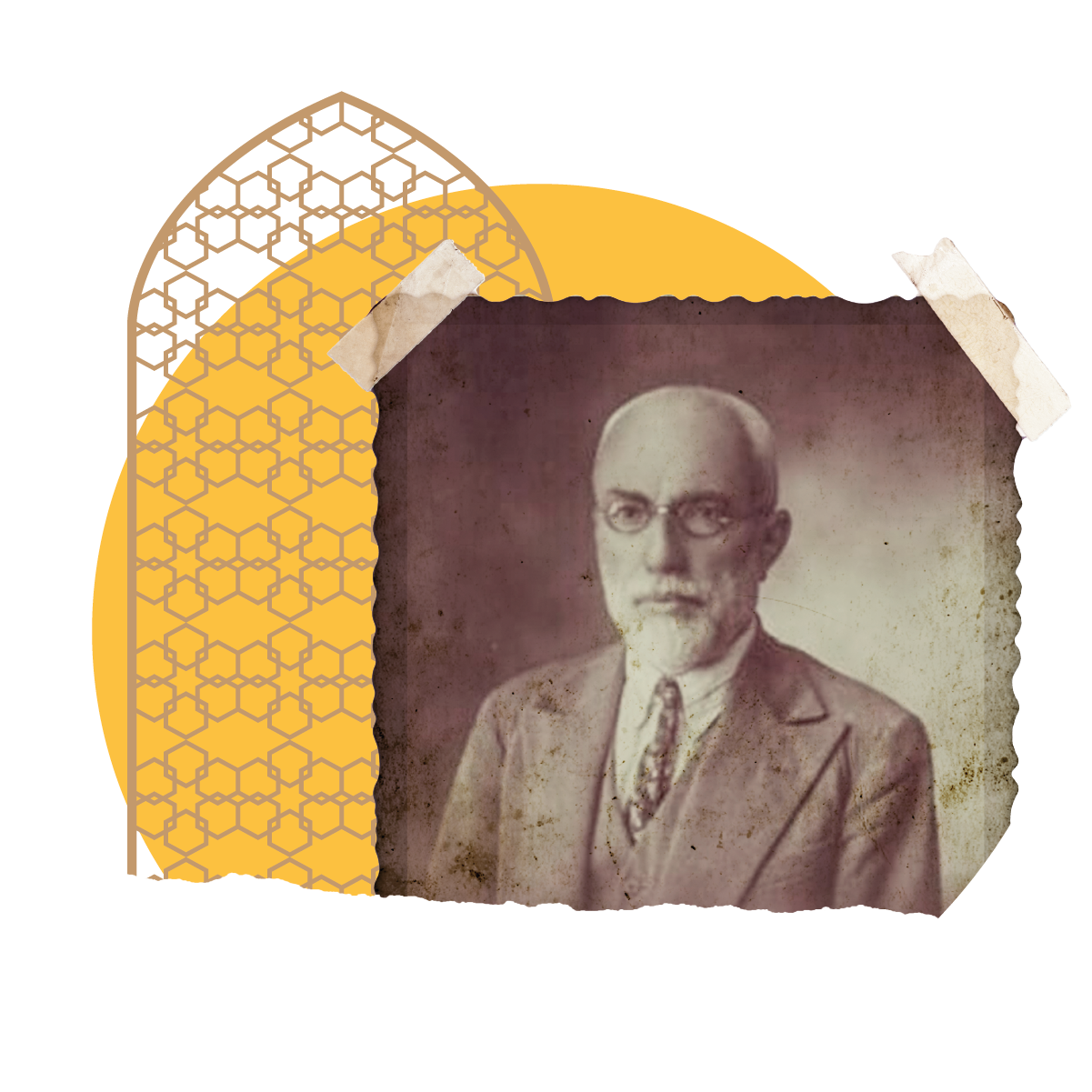
They were angry because the Prophet was from the Arabs
So, they attributed the Prophet Muhammad to the Turks
The Turks committed an ethical and media crime that offends the honorable lineage.

Under the pretext of the similarity of the names, they made the origin of the Prophet from the Turks in terms of soul and blood.

They started the process of distortion from the father of the Prophet Abraham in order to reconcile with their forgery.



1. Abd Al-Qadir Ibn Badran, Tahdhib Ibn Asaker, (Arab Heritage Revival Ho use) 2: 136-137.
2. Fouad Hamzah, Describing Kemalism Turkey “wasf turkia akmaliah”, (Dar Al-Jadid).
3. Al-Qalqashandi, The End of the Need to Know the Genealogy of the Arabs, (Dar Al-Kutub Al-Ilmiyya, 2012).
4. Muhammad bin Jarir Al-Tabari, History of Nations and Kings, (Dar Al-Kutub Al-‘Ilmiyya, 2011).
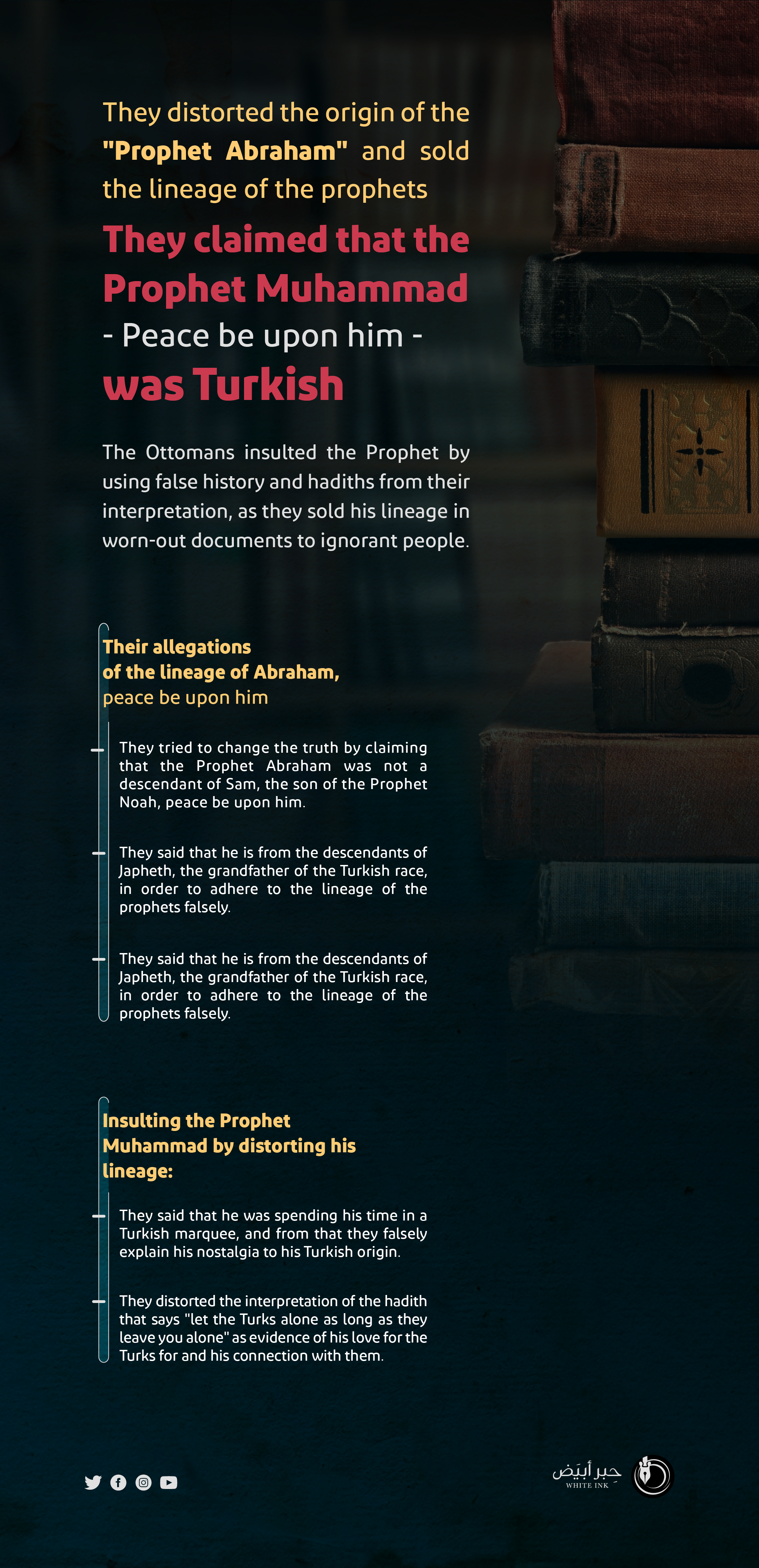

They sold the lineage of the Prophet
After they failed to attribute themselves to him
The professor at Istanbul University, Ismail Hakki Izmirli, was not satisfied with the wrong historical inference about the lineage of the Prophet Muhammad, but he relied on illogical assumptions, including that the Prophet used to perform I’tikaaf in a Turkish marquee, which indicates the Prophet’s nostalgia for his origin. This matter has nothing to do with a person’s longing for his origin, rather it is a personal matter of the Prophet Muhammad. Izmirli reiterates assumptions that are inconsistent with scientific facts and do not require evidence or proof of their validity.
They made assumptions that are inconsistent with logic, science, and knowledge of history and genealogy.

Izmirli mentions in the interpretation that the Prophet Muhammad used to mention the good qualities of the Turks, and says: “let the Turks alone as long as they leave you alone”. They interpret this hadith as a demonstration of the Prophet Muhammad’s love for the Turks due to his ethnic connection with them, while the hadith does not include any praise for the Turks. Indeed, there are hadiths that confirm that the Turks are the enemies, and that they will fight the Muslims in the epic of the end time. Abu Hurairah narrated that the Messenger of Allah said: “The Day of Resurrection does not come until you fight a people who make their sandals from hair. The Day of Resurrection does not come until you fight a people whose faces are rough and rounded with thick flesh”. [In another narration]: their eyes are small; their noses are short and curved and their faces are rough and rounded with thick flesh”. (Sahih Al-Bukhari: 2929). The explanation of the hadith is: The Prophet, may God’s prayers and peace be upon him, informs about one of the signs that will take place before the Resurrection. It is that the Muslims will fight a people who make their sandals out of hair, or that they lengthen their hair until the ends of their feet at the position of the sole. Also, from their characteristic features is that their faces are like gears made of leather, which are used to prevent sword strikes in war, and which are mounted layer upon layer. What is meant here is that their faces are rough and rounded with thick flesh. They can also be described that their eyes are small and their noses are short and curved. These are the descriptions of the Turks, the Tatars, and the Mongols.
They said: The Prophet spent his time in a Turkish marquee because he yearns for his Turkish origin.



1. Muhammad Nasir al-Din Al-Albani, The series of authentic hadiths (Riyadh: Dar Al-Maarif).
2. Fouad Hamzah, Describing Kemalism Turkey “wasf turkia akmaliah”, (Beirut: Dar Al-Jadid).

Before the idea of descent was formed in the Turkish race
Their ethnic connotation was based on the bullying system "Al-Fetewa"Their ethnic connotation was based on the bullying system "Al-Fetewa"
Suleiman Shah Ibn Qia Alp was the head of the Kayi tribe, one of the Turkish Ghaz tribes, with which Suleiman moved in the Anatolia region as its leader. This clan emigrated after being defeated by the Mongols in their original homeland in Turkestan in the year 617 AH / 1220 AD. They were concentrated on the plains of northern Siberia. Successive migrations took place through the Middle Ages until the modern era. They were known as the Turk. In this era, the Seljuk state was at its end as a state that had its historical role against the Byzantines.
The leader of the Kayi tribe did not find suitable conditions for their stability in the regions of Anatolia and decided to return to his motherland, but according to some Turkish sources, he died by drowning in the Euphrates River. Due to the absence of a leader, his clan was divided into two parts, one part decided to return to its first homeland, and the other part decided to head to the northeast of the Erzurum plains under the leadership of Artgrel bin Suleiman. Here there is an important note of the name of Suleiman, and after him his son Artgrel. They are understood as Arabic names and others that have a foreign connotation.
Considering that the region from which the Tatars came out was the one that brought out the Turks, the barbaric behaviors showed a common factor between them. Many historians have confirmed the cruelty of the Turkish race, and their use of the principle of force in their dealings, and it appears that Mongolian oppression was a fundamental factor in their successive migration.
After the disintegration of the Seljuk state, scattered Turkmen principalities emerged, including the independent and others.
This clan led by Artgrel extended along the borders of the Byzantine state in western Anatolia. The mountain sector from the Black Sea side from the Kastamonu region to Antalya was a haven for the Turks or Turkmen, as they are two sides of the same coin. They were pastoral areas that suit the nature of those coming from Central Asia, and what is remarkable is that they were accompanied by large numbers of dervishes and Sufis. This was according to Ekmeleddin Oglu, who said that they had been playing an important role for a long time in the spiritual life of these clans. He also states that the sheikhs and dervishes have converted the concept of “Al-Fetewa” into the concept of “Jihad”. This is a fact that cannot be denied, and they have practiced it in their military campaigns.
Many of them migrated to central and eastern Anatolia, and led their normal lives away from the Mongols. They invaded the Turkmen Emirates, especially its economy, to form an infrastructure for them. Those are the organizations that they relied on through the religious element represented by the “Mevlevi” order, and the fight against the Sunnis was clear in their dealings.
The political inflation of the Ottoman emirate that had grown up in Anatolia made it form a lineage other than military mercenaries.

The invasion that wore the garb of jihad was consistent with a model that took upon itself the constant jihad to expand the area of Islam and incursion towards Europe. One of the important observations here is that the Ottoman Empire, despite its incursion, did not spread Islam in Europe, and its countries or some of them did not convert to Islam, even though the Ottomans knocked on the doors of Vienna. What is the reason for this?
Ironically, the title invader is given to the leaders of their enemies if they really are their enemies. For example, Michal, who was one of the Byzantine military leaders, cooperated with the Ottomans, and everyone was subsequently fused into new groups. According to historical connotations, this is the beginning of the emergence of mercenary elements in the Ottoman Emirate.
Going back to the history of İnalcık, he says: “The aim of jihad was not to destroy the world of unbelief or war, but rather to subjugate it. Thus, the Ottomans established their empire by annexing the Christian Balkans to Muslim Anatolia under their rule. This empire protected the Orthodox Churches and millions of Orthodox Christians, even though it relied on jihad as its main principle”. Therefore, the deepened relations between Orthodox Russia and the Turkish state extended to the present day.
The ethnic origins from which the Ottomans descended, and which are shrouded in ambiguity in this aspect, confirm that the term “Ottoman” has no specific ethnic connotation. This term is considered a result of their mixing with the Seljuk Islamic depth and others in their neighboring regions. What confirms this is their lineage, which has been documented by a number of great historians.
The Turkish historian " İnalcık" explained the Turkish problem with the roots.



1- Ekmeleddin Ihsanoglu: The Ottoman State, History and Civilization, (Research Center for Islamic History, Arts and Culture, Istanbul, 1999).
2- Halil İnalcık: History of the Ottoman Empire from Establishment to Collapse, translated by Muhammad. M. Al-Arna`out (Al-Madar Al-Islami, Beirut, 2002).
3- Ali Hassoun: History of the Ottoman Empire and its Foreign Relations, (3rd Edition, Islamic Office, Beirut, 1994 AD).
4- Muhammad bin Muhammad bin Abi Al-Sorour Al-Bakri: alnzhah alzhiah fi Zkr wulaat msr walqahra alma’ziah, An investigation and study of: Hayat Manawir Al-Rashidi, (Dar Al-Raya Publishing, Cairo, 2016).
5- Muhammad Fouad Cobrilli: The rise of the Ottoman Empire, translated by: Ahmed Saeed Al-Salman, (Edition 2, Egyptian General Book Authority, Cairo, 1993).
6- Yilmaz Oztuna: History of the Ottoman Empire, (1st Edition, Faisal Finance Corporation, Istanbul 1988 AD).


